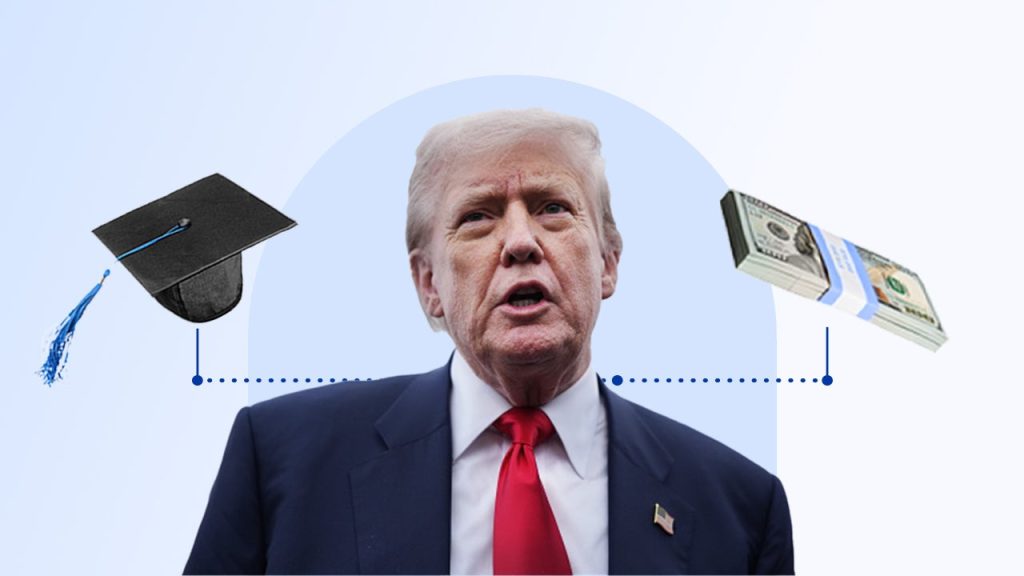Images by GettyImages; Illustration by Bankrate
About 200 days into the Trump Administration, leadership at both the White House and the Department of Education have attempted to reshape higher education, including how we repay the debt borrowed for it. And only once did they have to rely on student loan-related legislation — in the form of the broad One Big Beautiful Bill Act — to enact meaningful change.
Since January, Washington, D.C., politicians and policymakers have “flooded the zone.” And it doesn’t feel like an exaggeration to say their actions and words have caused chaos, at least for federal student loan borrowers.
“Certainly, the ground is moving under our feet, and we don’t quite know which way it’s going to shift,” says Tom Graf, who’s been the executive director at student loan lender MEFA for a quarter-century.
Here’s a tracker of movement to date:
- Jan. 27
-
The White House releases a surprise memo aimed at freezing federal funding. While it spooked federal loan borrowers, the memo was quickly rescinded.
- Feb. 3
-
The Department of Government Efficiency (DOGE) gains access to the federal student loan database. The Washington Post first reported the developments, setting off alarms about borrowers’ right to privacy and information security. A few weeks later, a federal judge blocked DOGE’s access.
- Feb. 13
-
The Consumer Financial Protection Bureau’s student loan ombudsman is fired. The ombudsman, Julia Barnard, was the one true gatekeeper of private student loan complaints and also aimed to protect borrowers from scams and poor service. (A few weeks after Bankrate interviewed Barnard on March 6, a court ruling determined that she and some of her colleagues should be reinstated; Barnard was back to work on April 7.)
- Feb. 27
-
The Education Department pauses IDR plan applications in light of a Feb. 18 court injunction blocking the SAVE Plan. Since IDR — short for income-driven repayment — is a lifeline for millions of federal loan borrowers, the pause (and lack of advance warning) sent many into a tailspin.
- March 3
-
The Senate confirms Education Secretary Linda McMahon. During and after her confirmation hearings, McMahon said she aimed to make good on Trump’s goal to “put yourself out of a job” by effectively winding down the department.
- April 21
-
The Education Department puts a fork in the idea of mass forgiveness. In the announcement, McMahon says, “The Biden Administration misled borrowers: the executive branch does not have the constitutional authority to wipe debt away, nor do the loan balances simply disappear.” In a Wall Street Journal op-ed published on the same day as the announcement, she insists, “Student loans must always be paid back.” (To be clear, student loan forgiveness is far from over, if not en masse.)
- May 5
-
The Education Department resumes debt collection for borrowers in default. Borrowers who were seriously delinquent on their loans were threatened with garnishment of wages and treasury offset, also known as the forfeiture of federal benefits like tax refunds and Social Security payments. (In June, however, the Department told the media that it had halted its plans to seize Social Security funds from senior education debtors.)
- May 29
-
The administration’s lawyers defend Biden-era rules that make borrower defense to repayment relief more accessible. This was a rare win for borrowers in the Trump era, and came as something of a surprise, given that the White House had asked the courts to delay its review of the case. (Unfortunately for borrowers, the Big Beautiful Bill would later roll back the Biden-era rules.)
- July 2
-
The Education Department concludes a negotiated rulemaking session aiming to rewrite PSLF eligibility rules — but fails to gain the consensus required to do so. The negotiating committee’s lone holdout told USA Today that “it’s very questionable, at best, for me, whether the Department of Education has the ability to remove PSLF-eligible status from any government employer or 501(c)(3).” (Experts expect the Department to unilaterally rewrite the rules in the near future, despite the certainty of facing court challenges.)
- July 9
-
The Education Department announces the end of the SAVE Plan forbearance. Starting August 1, borrowers enrolled in SAVE saw interest charges resume on their balances. These borrowers will also need to switch to another IDR plan — easier said than done — to maintain progress toward PSLF and other relief programs. The Department proposed IBR as the top alternative since it is the lone holdover IDR plan as the BBB provisions slowly take effect.
What to make of student loan news
As a certified student loan counselor, I’ve consistently reminded borrowers to ignore the headlines and wait for the analysis. Of course, it’s all too easy to get caught up in bluster. Just look at the first seven-plus months of the Trump Administration. If you hung on to every word regarding its treatment of federal student loans, you’d be exhausted. (Trust us, we are, since it’s our goal to monitor student loan news for you.)
So, give yourself a break from the outside noise and instead look inward. Control what you can by identifying the right repayment strategy for your situation, and optimizing it when changes are made official.
If you aren’t sure where to start, read up on income-driven repayment or, alternatively, how to pay off your loans fast.
Why we ask for feedback
Your feedback helps us improve our content and services. It takes less than a minute to
complete.
Your responses are anonymous and will only be used for improving our website.
Help us improve our content
Thank you for your
feedback!
Your input helps us improve our
content and services.
Read the full article here
